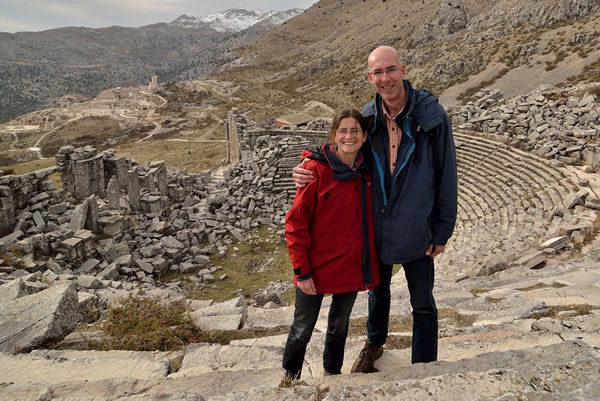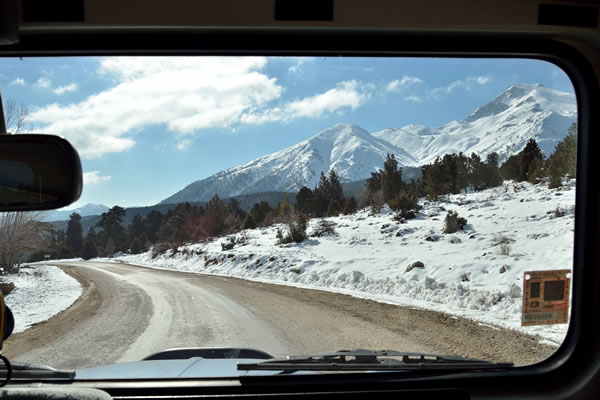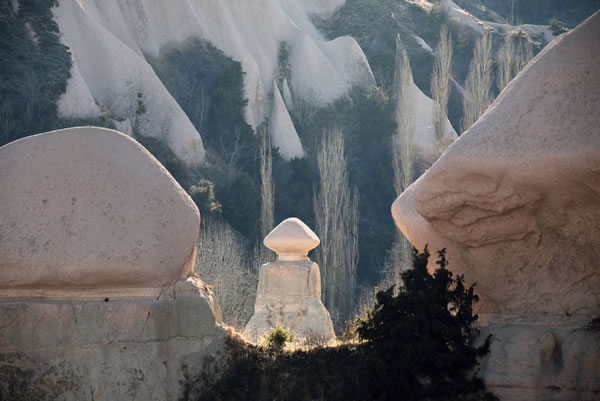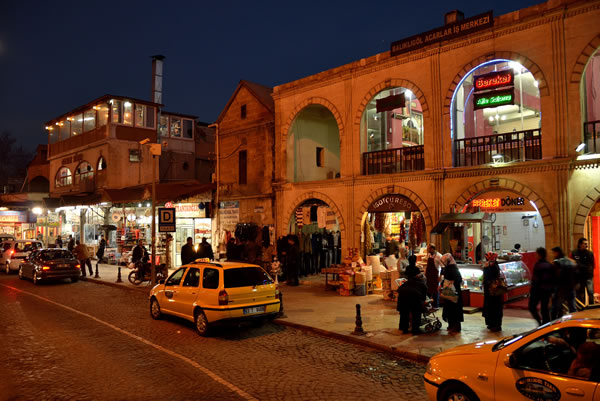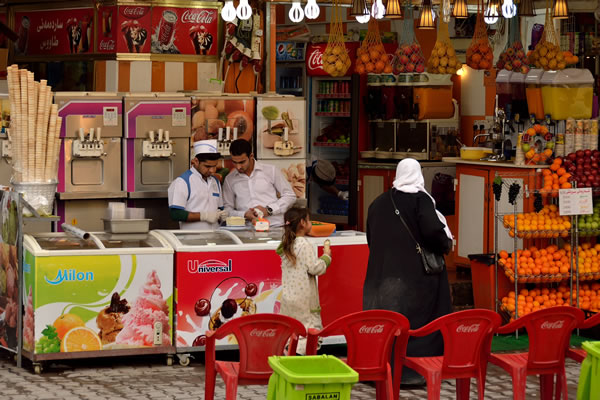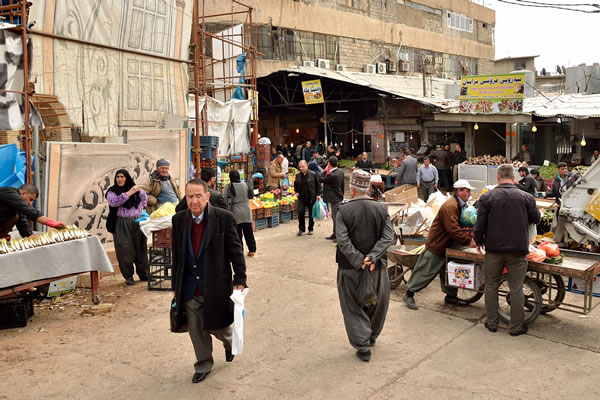It's time to leave the west coast of Turkey and travel inland eastwards. We have doubted whether we would drive along the south coast, because of the Mediterranean weather. The south coast is well-known by the popular resort towns such as Alanya, Side and Antalya, which undoubtedly sound familiar with holidaymakers who have ever made it for an all-inclusive vacation to the Turkish Riviera. The other option we had is to travel through the heart of Turkey. The weather in central Turkey is normally bitterly cold and wet in the winter. However, we're lucky this year. The winter of 2014 is mild and at this time it only freezes at night, there is only snow in the higher parts of the mountain regions, and days are sunny. So we eventually decide to take the route through the heart of Turkey, mainly because we think that we will see more of the traditional Turkey, further away from the coast.
Our first destination is Pamukkale. Pamukkale is one of the biggest tourist attractions in Turkey, thanks to its beautiful warm water terraces, which have emerged by a calcification process. However, the huge number of tourists has an impact on the natural phenomenon. To keep the terraces in good condition, everything is now managed in detail (like water flow, bleaching of terraces, places where visitor can walk, etc). Therefore, Pamukkale is nowadays more an amusement park than a natural phenomenon. We continue further eastwards and leave the main roads to drive the smaller country roads through the mountains. We pass small villages where time seems to have stood still, and where the donkey is still the most common form of transport. Along the way we visit the ruins of Sagalassos, which are already worth a visit, for its spectacular setting.
|
Another gem in the western part of Anatolia is Lake Egirdir. Once an important stopping point for caravans through this wild part of Turkey, and now primarily a wonderful tourist destination for local tourists. Not many foreign tourists come here (yet) because it is too far from the popular destinations. A ride through the snowy higher mountains takes us to Konya, one of the most conservative cities in Turkey, and the home of the Mevlana sect. The main reason for making a stop here is the Mausoleum of Mevlana. Mevlana was a poet and an Islamic writer from the early 13th century AD and was the founder of an important movement among Muslims in Turkey, the Mevlevi Sufis. A beautiful Mausoleum contains the sarcophagi of Mevlana, some of his family members, and his most important principal followers (see also the article "From Pamukkale to Cappadocia").
Eventually we settle for a while in Cappadocia, which has undoubtedly one of the most spectacular scenery in Europe (see photo impression). We make beautiful hikes in the surroundings and especially enjoy the fact that it is quiet in the low season. Many hotels and restaurants are closed, because the tourist numbers are too limited for them to be open. We have often said to each other that the high season is probably too busy to really enjoy the beauty of the area. With muscle pain in the legs, we drive to the southeast of Turkey. We visit the cities of Adana and Sanliurfa, and found the latter especially worthwhile. It is a pilgrimage city that attracts many believers because it is believed that Abraham was born in a small cave in the middle of the city (it is possible to visit the cave). But for us, the city of Sanliurfa was mainly the first city where we really had the feeling for the first time that we were approaching the Middle East. The clothing suddenly changed, and due to the proximity of Syria, we saw for the first time Arab influences.
|
| We were very lucky that we had the opportunity to visit Mount Nemrut. Normally this mountain is inaccessible during this time of the year because of snow, but thanks to the mild winter we could visit the mystical stone statues on top of the mountain (see also the article and the photo impression of Mount Nemrut). We then crossed the Euphrates River and drove to Diyarbakir, the city that is most associated with the struggle of the Turkish Kurds for more autonomy. A day before we arrived there were riots because of the anniversary of the arrest of their leader Ocalan, by the Turkish authorities. But by the time we arrived, everything as cleaned up, and Diyarbakir was transferred again in a friendly, neat and quiet town in the Kurdish heartland (see photo impression).
We continue our journey eastwards via the towns of Mardin and Midyat. We are on the way to the border with Iraq. Mardin is hyped as a jewel of a honey-coloured town, built on the side of a hill. We stay there for a few days, but the town cannot really make much impression on us. The same applies to Midyat, a similar town, but without the mountain setting. Just outside Midyat is now a refugee camp with approximately 4,500 Syrians, who have fled the violence in their home country. The large amounts of refugees give the town a bit of a grim atmosphere with lots of young guys hanging around with nothing more to do than hanging around, throwing stones and nagging passing people. From Midyat it is only 140 kilometres to the Iraqi border.
We choose the Iraqi route to avoid the winter weather in the mountains that separate Turkey and Iran. Of course, we only stay in the Kurdish part of Iraq, a safe destination in an otherwise torn Iraq. The border crossing with Iraq does not go smoothly because it seems that is actually not allowed to take a car out of the country through another border post than where the car entered country (see also the article "Turkish - Iraqi border: Ibrahim Khalil"). But we are nevertheless warmly received by the border officials, and thanks to the tenacity of Salem (border official), we finally get permission to take the car through the country to Iran. We stay the first night in Iraq just over the border in Dohuk, and drive the next day through a beautiful landscape to Erbil (see also the article: "On the road to Erbil"), where we enjoy a few days of the Iraqi-Kurdish hospitality. The final destination in Iraqi Kurdistan, before we cross the border with Iran, is the city of Sulaymaniyah, seen by many as the most cosmopolitan city in Iraq. The people here are again very friendly and there wasn’t a moment that we thought that we were in a ‘dangerous’ area. The Kurdish people are very friendly, hospitable and convinced that visitors are safe in ‘their’ country Kurdistan. Iraqi Kurdistan is a responsible destination, and at present, it is certainly worth considering for the adventurous travellers who are looking for a new destination in the Middle East.
|
